The Breakwater Gaol was a prominent feature on Cape Town's shoreline long before Robben Island achieved worldwide renown as a prison. During the 19th century the gaol was one of the most feared in the world, a place that ranked with Dartmoor and Devil's Island. Geocachers visiting the Cape Town Waterfront can still form an idea of the horrors of this prison by walking through the open gates in Portswood Road and using the waypoints of this virtual cache to see the treadmill, the solitary confinement and death cells, and the graffiti scratched on the old prison walls. A walk of about 70 meters is needed from the entrance to the three waypoints.
Logging Requirements
To log this cache three questions must be answered and the answers sent via my geocaching profile. The questions can only be correctly answered by visiting the site and making observations at the three waypoints provided. Logs without answers will be removed.
Question 1. In 1861 what percentage of the prison population was "Europeans and those of European Descendants"?
(Waypoint S 33 54.403 E 18 24.972 Historical Route Plaque #6).
Question 2. How many curved spokes are there in the brake-wheel that the prison warders used to control the speed at which the treadmill rotated. The brake-wheel can be seen immediately to the north of the treadmill.
PLEASE DON'T CLIMB ONTO THE TREADMILL.
(At GZ S 33 54.394 E 18 24.980)
Question 3. At Waypoint S 33 54.400 E 18 24.991 there is historical graffiti depicting an Ox and an African warrior holding a shield and spear. (A photograph of this graffiti appears in the text that follows). What is the date (the year) that is carved immediately below the warrior's feet?
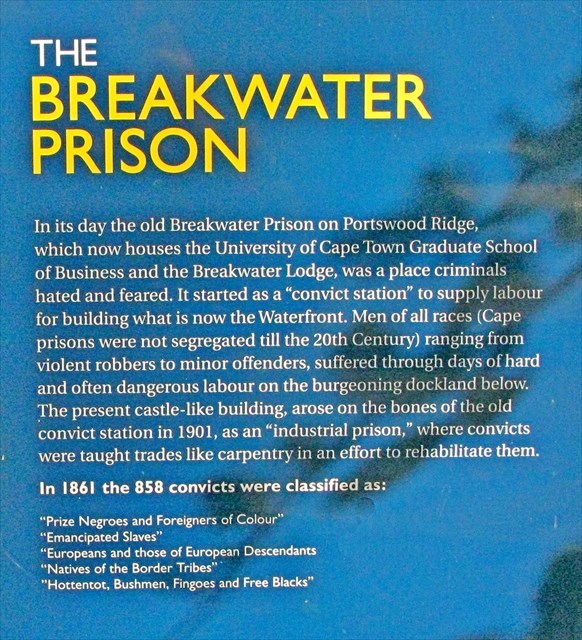
History of the Breakwater Gaol
In July 1846 Mr. W. E. Gladstone, British Secretary to the Colonies, presented to the British Cabinet a dispatch from the Governor of the Cape urging the need for a breakwater to protect the shipping in Table Bay during winter storms. Mr. Gladstone suggested that it should be built using convict labour. Consequently construction of the first Breakwater Gaol (by convict labour) was completed in 1859 and work on the harbour breakwater itself started in 1860. The breakwater was built by the convicts held in the Breakwater Gaol. There were in fact two Breakwater Gaols: one built in 1859 and a second built between 1890 and 1905 within the walls of the 1859 gaol. Together these were the Cape Colony's largest and most feared gaol for most of the 19th century.
Situated just to the east and below the Gaol, is the quarry that was excavated to obtain the rock that was used to form the harbour breakwater.. (Today, the Two Oceans Aquarium and the One&Only Hotel stand on the edge of the flooded quarry -- now a marina.)
During the second half of the 19th century I.D.B. (illicit diamond buying on the Kimberley fields) was being punished savagely in an attempt to stamp out the traffic. Magistrates sentenced offenders to ten years' hard labour for this crime the minimum sentence was five years. There was no option of a fine. Thus scores of men -- both black and white -- who were not criminals in the ordinary sense, were sent to the breakwater for being found in possession of uncut diamonds. As one writer in 1895 remarked: " The breakwater depends entirely for its rate of progress on the output of I.D.B. convicts from Kimberley."
Through dabbling in I.D.B. doctors, lawyers, army officers, and both educated and illiterate men were sentenced to hard labour building the breakwater and imprisoned in the custom-built gaol. They wore prison uniforms marked with the "broad arrow", and each man had his number stamped on the back of his jacket. Dangerous prisoners worked in chains. Rings were riveted round their ankles, and they lived in chains for months at a time.
Some British convicts were guilty of no more than having jumped ship at the Cape. They had been press-ganged into maritime service at Portsmouth and found life at sea too much for them. But jumping ship was an offence punishable by hard labour. Before 1885 each white convict slept with a convict of colour on each side of him-to reduce the risk of communication between the white convicts. Sometimes there would be a thousand convicts within the walls. The composition of the prison's inmates in 1861 is shown in the adjacent photograph.
After a prisoner strike in 1885, the prison authorities decided that the interracial contact had caused the trouble and decided to have separate prisons for black and white convicts. The Industrial Breakwater Prison (the existing four-turret building) was consequently built by the convicts themselves. White male convicts were held here between 1905 and 1923. In 1905 most of the black convicts from the 1859 gaol were transferred to the Kimberly gaol though some were hired out to the Harbour Board at 6 pence per day to work in the docks. Between 1926 and 1985 the turreted building was used as a hostel for dock labourers. In the early 1990s, the derelict buildings were renovated to accommodate the business school of the University of Cape Town. The GSB has had its home here since 1991.
Prison Punishment
The law was harsh. Convicts recaptured after a "break" usually received six months hard labour and twelve lashes with the cat-o'-nine-tails. In later years the maximum number of strokes was reduced to ten ; but it was still a punishment that scarred a man for life. The prisoner was stripped to the waist and fastened by the wrists to a triangle. Each stroke was delivered with all the force a muscular warder could apply. It sounds like medieval torture, and it was.
Special cells were built in the prison in 1891 to hold repeat offenders in solitary confinement. The two old death cells still remain at the east end of the isolation cells. (Gallows Hill, today the location of Cape Town's Traffic Department, was not far from the gaol, just across the quarry .) To complete this geocache you will walk past these steel and concrete cells with walls 40 cm thick.
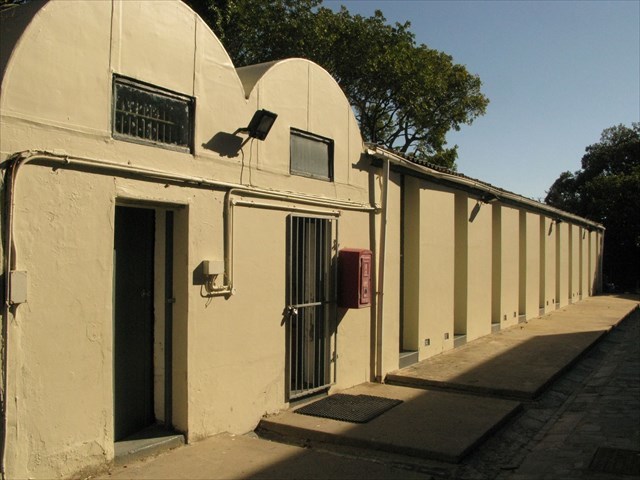
The death and isolation cells of the Breakwater gaol
Among the lesser punishments at the Breakwater Prison was the treadmill. The first breakwater treadmill was installed in the eighteen-seventies, and it held two victims at a time. A larger one, capable of holding six men at once, was built in the eighteen-nineties. A treadmill is something like a revolving staircase made up of a series of rotating wooden planks. Prisoners had to keep a steady pace and if they slowed down, the rotating planks could lacerate or even smash their shins. A man could spend an entire day from 9.00am to 5.00pm climbing these endless steps with only five minutes rest every half hour. On a cold day, with a kind-hearted warder using the brake mercifully, the treadmill was tolerable. But in summer a sadistic warder would inflict torture by allowing the wheel to rotate too fast. Men who revolted against the punishment were handcuffed to a bar, and there they hung with every turn of the mill bruising their legs. Although use of the treadmill as a form of punishment was abolished in 1905 the treadmill still exists at the west end of the row of isolation cells. It is reputedly the only remaining treadmill on the African continent.
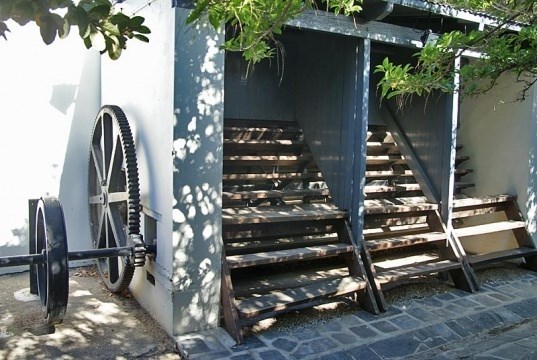
The treadmill at the Breakwater gaol
Grafitti
On the wall of the original prison the remains of graffiti carved into the hard rock by inmates is still visible. (White painted arrows point to many of the sites.) Many scratchings are hard to decipher and are merely names and dates, others depict flags and imagined coats of arms.
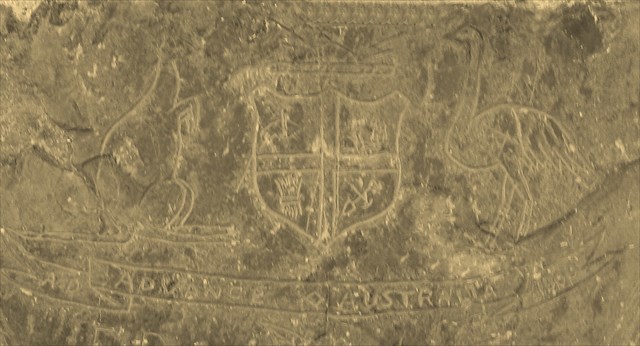
Prison graffiti: stylised Australian Coat of Arms
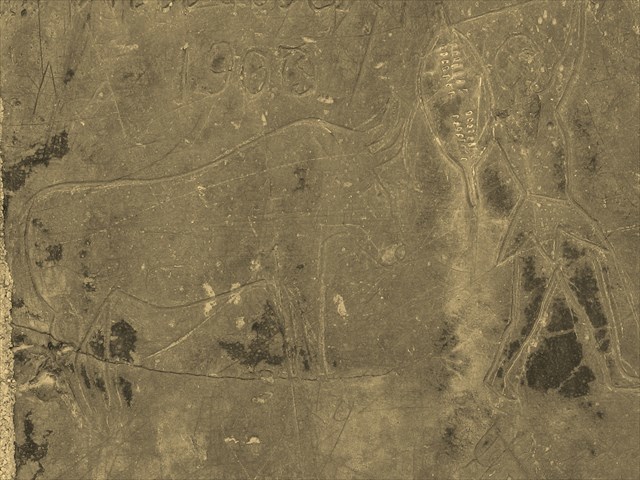
Prison graffiti: Ox and African warrior
Sources
Lawrence G Green, Chapter 11, Tavern of the Seas, Howard Timmins, 1947.
Breakwater Gaol Treadmill: Man's inhumanity to Man, Cape Info Myths, Legends and Old-folks Stories: The Breakwater Gaol Treadmill
Harriet Deacon, A History of the Breakwater Prison from 1859 to 1905, Honours Degree Thesis, University of Cape Town, 1989.
Virtual Rewards 2.0 - 2019/2020
This Virtual Cache is part of a limited release of Virtuals created between June 4, 2019 and June 4, 2020. Only 4,000 cache owners were given the opportunity to hide a Virtual Cache. Learn more about Virtual Rewards 2.0 on the Geocaching Blog.